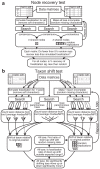Fossilization causes organisms to appear erroneously primitive by distorting evolutionary trees - PubMed (original) (raw)
Fossilization causes organisms to appear erroneously primitive by distorting evolutionary trees
Robert S Sansom et al. Sci Rep. 2013.
Abstract
Fossils are vital for calibrating rates of molecular and morphological change through geological time, and are the only direct source of data documenting macroevolutionary transitions. Many evolutionary studies therefore require the robust phylogenetic placement of extinct organisms. Here, we demonstrate that the inevitable bias of the fossil record to preserve just hard, skeletal morphology systemically distorts phylogeny. Removal of soft part characters from 78 modern vertebrate and invertebrate morphological datasets resulted in significant changes to phylogenetic signal; it caused individual taxa to drift from their original position, predominately downward toward the root of their respective trees. This last bias could systematically inflate evolutionary rates inferred from molecular data because first fossil occurrences will not be recognised as such. Stem-ward slippage, whereby fundamental taphonomic biases cause fossils to be interpreted as erroneously primitive, is therefore a ubiquitous problem for all biologists attempting to infer macroevolutionary rates or sequences.
Figures
Figure 1. Results of simulated fossilization analyses.
(a) Node recovery test, indicating significantly lower phylogenetic signal recovery for simulated fossilization searches (hard characters only) vs random missing characters in the same amount, but not for inverse-fossilization searches (soft characters only). Node recovery is the proportion of 2022 original strict consensus nodes recovered with systematic missing data or random missing data (the later being an average of 500 iterations with twice standard deviation error bars); (b) Taxon shift test, where soft characters are removed from individual taxa to simulate fossilization. Histograms represent shift from original position (x o), to new position (_x_†) relative to the root for all simulated fossil taxa that moved (above) and simulated fossil taxa that exhibit significant shift, given random missing data (below). In the case of the later, 61% of 491 taxa shift significantly down phylogenies, from their original position toward the root, vs 39% which shift significantly up; (c) the effect of a downward shift of a fossil taxa in a phylogeny on estimates of rates of evolution and inferences of timing of evolutionary events (pink bars represent evolutionary changes e.g. DNA base pair change or acquisition of a morphological character). Images in Figure 1a adapted from Gilbert and Duane.
Figure 2. Schematic protocol of analyses.
(a) Node recovery test; (b) Taxon shift test. Scripts for tests are available online (Supplementary 1–2).
Similar articles
- Bias and sensitivity in the placement of fossil taxa resulting from interpretations of missing data.
Sansom RS. Sansom RS. Syst Biol. 2015 Mar;64(2):256-66. doi: 10.1093/sysbio/syu093. Epub 2014 Nov 27. Syst Biol. 2015. PMID: 25432893 Free PMC article. - Phylogeny of extant and fossil Juglandaceae inferred from the integration of molecular and morphological data sets.
Manos PS, Soltis PS, Soltis DE, Manchester SR, Oh SH, Bell CD, Dilcher DL, Stone DE. Manos PS, et al. Syst Biol. 2007 Jun;56(3):412-30. doi: 10.1080/10635150701408523. Syst Biol. 2007. PMID: 17558964 - Geometric morphometric character suites as phylogenetic data: extracting phylogenetic signal from gastropod shells.
Smith UE, Hendricks JR. Smith UE, et al. Syst Biol. 2013 May 1;62(3):366-85. doi: 10.1093/sysbio/syt002. Epub 2013 Jan 16. Syst Biol. 2013. PMID: 23325808 - Soft-Bodied Fossils Are Not Simply Rotten Carcasses - Toward a Holistic Understanding of Exceptional Fossil Preservation: Exceptional Fossil Preservation Is Complex and Involves the Interplay of Numerous Biological and Geological Processes.
Parry LA, Smithwick F, Nordén KK, Saitta ET, Lozano-Fernandez J, Tanner AR, Caron JB, Edgecombe GD, Briggs DEG, Vinther J. Parry LA, et al. Bioessays. 2018 Jan;40(1). doi: 10.1002/bies.201700167. Epub 2017 Nov 29. Bioessays. 2018. PMID: 29193177 Review. - Morphological homeostasis in the fossil record.
Webster M. Webster M. Semin Cell Dev Biol. 2019 Apr;88:91-104. doi: 10.1016/j.semcdb.2018.05.016. Epub 2018 May 30. Semin Cell Dev Biol. 2019. PMID: 29787861 Review.
Cited by
- Bayesian molecular clock dating of species divergences in the genomics era.
dos Reis M, Donoghue PC, Yang Z. dos Reis M, et al. Nat Rev Genet. 2016 Feb;17(2):71-80. doi: 10.1038/nrg.2015.8. Epub 2015 Dec 21. Nat Rev Genet. 2016. PMID: 26688196 Review. - Differences between hard and soft phylogenetic data.
Sansom RS, Wills MA. Sansom RS, et al. Proc Biol Sci. 2017 Dec 20;284(1869):20172150. doi: 10.1098/rspb.2017.2150. Proc Biol Sci. 2017. PMID: 29237859 Free PMC article. - The Making of Calibration Sausage Exemplified by Recalibrating the Transcriptomic Timetree of Jawed Vertebrates.
Marjanović D. Marjanović D. Front Genet. 2021 May 12;12:521693. doi: 10.3389/fgene.2021.521693. eCollection 2021. Front Genet. 2021. PMID: 34054911 Free PMC article. - Ancestral morphology of Ecdysozoa constrained by an early Cambrian stem group ecdysozoan.
Howard RJ, Edgecombe GD, Shi X, Hou X, Ma X. Howard RJ, et al. BMC Evol Biol. 2020 Nov 23;20(1):156. doi: 10.1186/s12862-020-01720-6. BMC Evol Biol. 2020. PMID: 33228518 Free PMC article. - Morphological and molecular convergences in mammalian phylogenetics.
Zou Z, Zhang J. Zou Z, et al. Nat Commun. 2016 Sep 2;7:12758. doi: 10.1038/ncomms12758. Nat Commun. 2016. PMID: 27585543 Free PMC article.
References
- Benton M. J. & Donoghue P. C. J. Palaeontological evidence to date the tree of life. Mol. Biol. Evol. 24, 26–53 (2007). - PubMed
- Donoghue P. C. J. & Benton M. J. Rocks and clocks: calibrating the Tree of Life using fossils and molecules. Trends in Ecol. Evol. 22, 424–431 (2007). - PubMed
- Benton M. J., Donoghue P. C. J. & Asher R. J. In: The Timetree of Life ed. 25–86 (Oxford University Press 2009).
- Donoghue M. J., Doyle J. A., Gauthier J., Kluge A. G. & Rowe T. The importance of fossils in phylogeny reconstruction. Ann. Rev. Ecol. Syst. 20, 431–460 (1989).
Publication types
MeSH terms
LinkOut - more resources
Full Text Sources
Other Literature Sources

